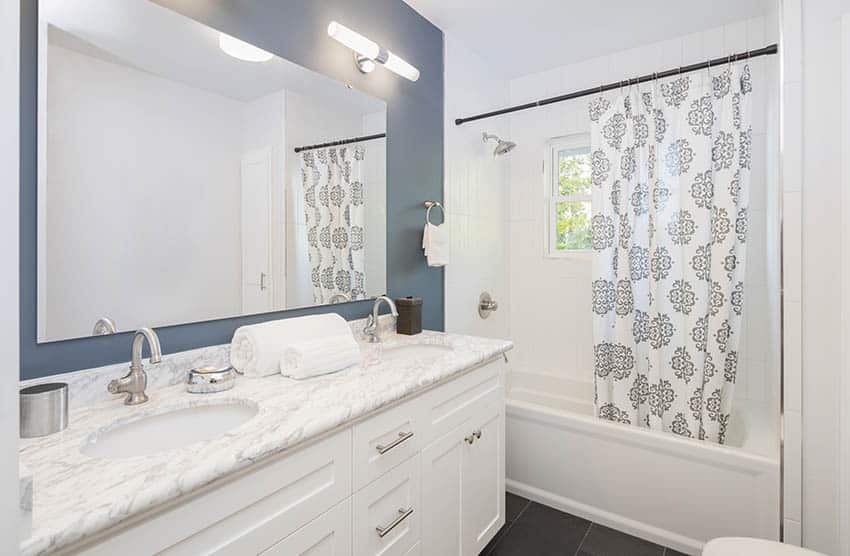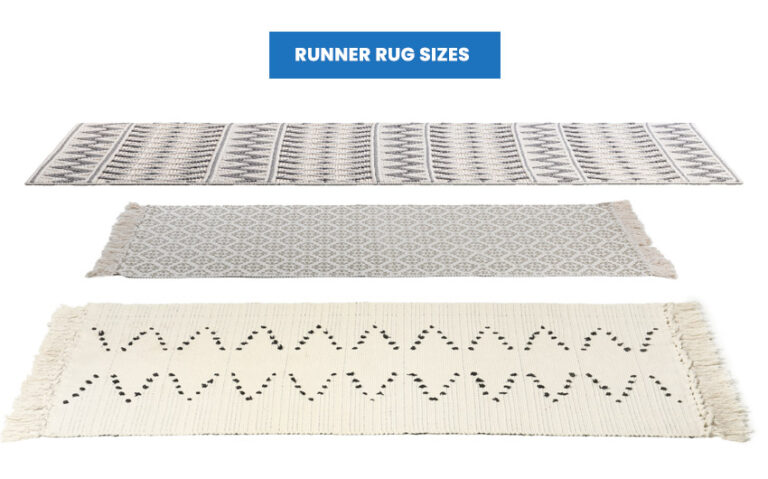Most Popular Shower Curtain Sizes & Measuring Tips

Finding the right shower curtain means more than matching your decor. If the curtain is incorrectly sized, you’ll have problems ranging from aesthetics to coverage and even issues related to moisture build-up. This becomes particularly important when you have just gotten out of a small bath and are trying to reach for your towels without getting water everywhere. The good news is that finding the right curtain size for your bathroom isn’t difficult. These easy tips will help you find the right shower curtain sizes for your bathroom with no problem.
Standard Bathroom Curtain Size
Sizes that are considered “standard” for shower curtains are based on standard-sized tubs and showers. This includes covering a 60” tub properly. In addition, it includes up to 12” so that when closed, it isn’t pulled tight. Rather, it offers the appearance of folds even when it’s completely shut across the tub. These measurements include the following:
● 70” x 70”
● 70” x 72”
● 72” x 72” – Most Popular Standard Size

As for tub style, these measurements work best for the average in-set tub. These won’t necessarily work for a freestanding tub that needs a curtain to wrap around it. We’ll look at how to account for these shower and tub styles later. For walk-in showers, you will most likely need extra long curtains. These are generally around 78″ in length.
Shower curtains come in various sizes, just like many other home products. While most tubs and shower designs accommodate standard sizes, there are many different options. Even still, it’s important to measure your tub or shower to check the size you need before assuming a standard shower curtain will fit.
What Size Curtain Do You Need?
The curtain you’ll need depends heavily on your tub or shower size. However, the measurements of the dimensions of your enclosure will not exactly match the measurements of your curtain. Instead, there are a couple of factors that you’ll want to take into account.
In the following sections, we’ll discuss how to use the measurements from various tub and shower types and even go over a handy table to help you find the size you need.
How to Measure Curtain Sizes
When measuring the width of shower curtain sizes, you’ll want to start by measuring the width of your shower from wall to wall. As mentioned, you don’t want to purchase one that reaches wall to wall when pulled taut.
Instead, you want to add 12” to the measurement you took so the curtain has enough space to create folds even if fully closed. This is the appearance that most homeowners prefer, and it’s much easier to fully cover the opening when you have this fail-safe of an extra foot of fabric.
Measuring height is slightly different because you don’t want to measure from the ceiling to the floor. You also don’t want to leave much extra space because you don’t want the curtain to drape onto the floor or, even worse, pool at the bottom. This invites moisture-related problems such as mold and mildew.
Instead, measure the curtain rod to the floor. To ensure that it doesn’t drape onto the bathroom floor, account for the rings you’ll hang them off of and subtract about 1″ to 3” from your initial measurement (or the exact size of the rings).
Measuring Curtains for a Freestanding Shower/Tub
Freestanding tubs and shower stalls are slightly different to measure than a standard tub or combination shower. Yet, they aren’t difficult to measure for either. Typically, you want to use the same measurements for the curtain’s height. After all, you still don’t want them to hang onto the floor or be too short for the tub.
Adjusting the width is easy to do. Instead of measuring from one wall to another, you want to measure around the exposed sides of the tub or stall your fabric will cover. Don’t forget – you still want to add an extra 12” to the length of your shower curtain so that it is large enough to fold nicely still when it’s pulled shut and fits the tub or stall completely.
Curtain Dimensions Chart

Since the formula for finding your shower curtain size proportional to the measurement from your tub is so easy, it’s easy to create an estimation for you. You’ll still want to double-check your tub or enclosure measurements, but you can use this table to make your job a little easier in the long run.
Measurements are Width by Length:
- 72” x 72” – Most Popular Standard Size
- 84″ x 74″ – Extra Wide Bathtub
- 54″ x 78″ – Enclosure/Stall
- 70″ x 84″ Extra Tall
- 72″ x 96″ Floor to Ceiling enclosure/Stall
What Size Is An Extra Long Curtain

An extra-long shower curtain most often measures 70″ by 84″. This is also the same measurement for an extra-tall one. Other sizes for an extra long are 72″ by 84″. Extra long shower liners can measure 144″ by 72″, which provides more material to keep water from going where it’s not wanted.
Where to Hang a Curtain Rod

If you don’t know where to hang your shower curtain rod, the instructions we’ve given for finding the height of your curtain might be more than a little confusing. Luckily, there is a way to find out where to hang your rod if you already know your curtain’s length.
Start with the length of the shower curtain you want to hang. Remember, you don’t want this to hang at a height that it will drag or pool on the floor. As such, you’ll want to account for this by adding an extra 2” onto the pre-existing height of the curtain.
Then, measure the size of the hooks you’ll be using to see how far down from the rod it will hang. When you add these three measurements together, you have the height of your shower rod. In short, the equation looks like this:
2” + [curtain length] + [Hook size] = [rod height]
For example, if you have a 70” to 72” tall curtain, your rod height will likely sit around 75” to 77”.
When you’re choosing, you shouldn’t just consider the product style. Even the most beautiful design will look off in a bathroom if it isn’t sized to fit properly. If you would like to upgrade the look of your bathroom, you may also consider installing shower doors. For more related information check out our article on shower doors here.







Hi,
I need a real short shower curtain because I have a Safe Step walk in tub. Understand that 48”” in length is good. Please advise.
That is a good questions which I am unsure of the answer. I noticed that the model I looked at was 39″ tall which should allow a 48″ long curtain to work. However, to be sure I would contact the Safe Step manufacturer for their advice regarding the best length for a shower curtain for the model tub/shower combo you have.
I have a curved shower curtain rod in my apartment bathroom, the standard curtain is not wide enough? Would the 84 inch work?
I’m trying to replace 2 shattered glass doors by buying a curtain to save money. The glass doors were framed with a nickel frame. If I put a small rod between the inside & outside the frame, I find the length I need is 66 inches to just touch the floor. I measured the with 46 inches wide and by added the 12 inch as directed, the with would be 58 inches. Everything I read is either 70 or 72 inches long which would drag a lot on the floor. Any suggestions what I should do?? P.S. we were cleaning the glass doors to sell the house when they shattered. Can’t spend much money! HELP!!!
Replacing shower/tub unit with walk-in shower. Shower head 81”from floor, width of opening is 52”. What size curtain would be best? Thank you.
The minimum width for curtain’s are 1.5 times the opening width. A 52″ opening × 1.5 = 78″. An extra-wide curtain measuring at least 78″ wide would work. Since your shower head is 81″ high, it should also extend at least a few inches higher to prevent spray. So a length of 84″ or longer to reach near the floor is a good idea. You’ll need to determine if this height works on where your rod can mount and if it looks good in that position. A 78″ wide x 84″ long product may be difficult to find so you may need to go with an 84″x 84″ and have it be more bunched or have a custom size created. Hope this helps!